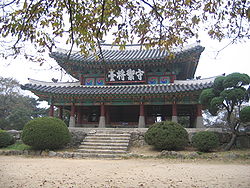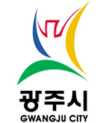Gwangju, Gyeonggi
|
Gwangju 광주시 |
||
|---|---|---|
| Municipal City | ||
| Korean transcription(s) | ||
| • Hangul | ||
| • Hanja | ||
| • Revised Romanization | Gwangju-si | |
| • McCune-Reischauer | Kwangju-si | |
 |
||
|
||
 Location in South Korea |
||
| Country |
|
|
| Region | Sudogwon | |
| Administrative divisions | 3 eup, 3 dong, 4 myeon | |
| Area | ||
| • Total | 430.99 km2 (166.41 sq mi) | |
| Population (December 2013) | ||
| • Total | 286,699 | |
| • Density | 665.2/km2 (1,723/sq mi) | |
| • Dialect | Seoul | |
Gwangju (Korean pronunciation: [kwaŋ.dʑu]) is a city in Gyeonggi Province, South Korea, a suburb southeast of Seoul. The city is not to be confused with the much larger Gwangju Metropolitan City, former capital of South Jeolla Province, South Korea. Bunwon-ri in Gwangju took an important role of ceramic production during the Kingdom of Joseon. There had official kilns and produced superb quality of white porcelains for use at the royal court and to export to China.
In 1962, 4 myuns(towns) including 5 ris(townships) were incorporated to Seoul.
In 1973, 6 of ris were separated and these came to parts of Seongnam city. In 1979, gwangju myun promoted eup. In fact, Gwangju was a county but became a city in 2001.
Coordinates: 37°22′N 127°17′E / 37.367°N 127.283°E
...
Wikipedia

